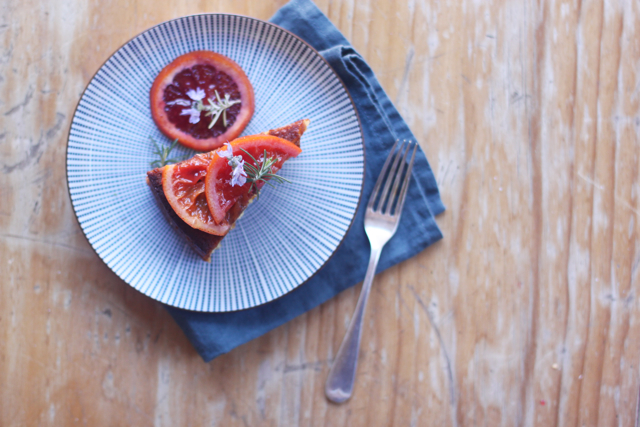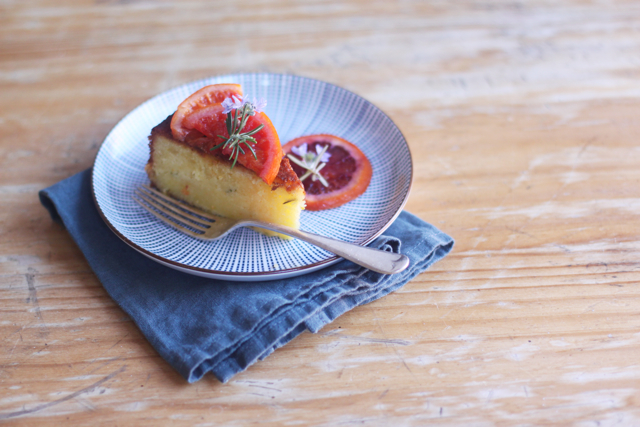This time tomorrow I will be skipping seasons, leaving this glorious Australian spring for Tuscan autumn – my favourite time of year in my favourite place, I must admit. It’s only for a couple of weeks but I’ll relish this time and make the most of cool mornings, fresh mushrooms, grapes, new olive oil.

But just before I go, is this cake. I first caught a glimpse of this beautiful cake via Julia from Ostro. I was immediately obsessed with the idea of making it. It sounded right up my alley — she learnt it from a nonna in Tuscany, it has perfect, easy to remember proportions, it’s made with olive oil and citrus (two of my favourite cake recipe ingredients) and it’s not fiddly. And because we had just snapped up some lovely deep, dark late season blood oranges from the market, they became the star of the show. There’s something so dramatic about them from their blood red flesh and juice to their bittersweet flavour.

The result is a wonderfully moist, dense, citrusy cake that is even better a day or two old, if you can make it last that long, that is. I also slipped in a bit of rosemary from the garden, just enough for some subtle herbiness and a bit of contrasting speckling throughout the cake. As Julia suggests, you can use different citrus fruits for this.
I made some semi-candied blood orange slices to place on top just to show off their beautiful jewelled colour. The slices are simply boiled in some sugar and juice until the juices get thick and syrupy.

Simple blood orange cake, barely adjusted from this “orange olive oil” cake recipe from Ostro:
- 2 blood oranges, zest and juice
- 300 grams sugar
- 3 eggs
- 300 grams extra virgin olive oil
- 300 grams milk
- 300 grams flour
- 1 teaspoon baking powder
- pinch of salt
- 1-2 large sprigs of fresh rosemary, leaves finely chopped
Grease and line a 23cm cake tin. Rub the zest through the sugar until fragrant. Beat in the eggs until creamy and thick. Add the milk, olive oil and orange juice and stir. In a separate bowl, combine the flour, baking powder, salt and rosemary. Make a well in the centre of the flour mixture and slowly pour the wet ingredients into it, stirring gently as you go with a spatula or wooden spoon. Mix until just blended then pour into cake tin. Bake at 180C for 45-50 minutes or until golden brown and a skewer inserted in the middle comes out clean.
For the semi-candied blood orange slices (following part of this recipe from Gourmet Traveller):
- 1 blood orange, sliced into 5mm thick slices
- 100 grams sugar
- 1/4 cup blood orange juice
Place ingredients in a small saucepan and simmer for about 15 minutes or until orange pieces are soft enough for a fork to easily pierce the skin and the juice has thickened. Arrange the orange slices over the baked, cooled and plated cake. Pour over the syrup as evenly as possible. A couple of rosemary sprigs and flowers (which should be in bloom the same time that end of season blood oranges are lovely and dark) also make a pretty garnish.




Comments
Emiko,
I love your simple styling. So classic and the food is the focus with minimal distractions. 🙂 Love the second photo!
Thanks Asha!
I love the texture of the cake! Olive oil and citrus are among my favourite ingredients, too. I’ll try it soon!
I’m quite positive you’d love this; let’s try a gluten-free version!
Gorgeous post. I am deep in a Midwestern autumn right now and I think this cake would fit perfectly.
Oh yes. And if you can’t get blood oranges just yet, try any citrus, even lemons!
I love the idea of rosemary in a cake, must be amazing, but the amount of olive oil looks too much too me. Anyway, i might give it a try. Emiko, wish you a great trip to this part of the world and looking forward to hear and see the photos you will for sure share.
It might sound like a lot of liquid but I can assure you the resulting cake has the most wonderful texture! Do give it a try 😉
We made this cake, and while delicious for the most part, turned out soggy from olive oil. Your results may vary, but beware!
Sounds like something went a little wrong. This could have happened for many reasons, from the oven not being hot enough to something happening to the mixture. I went back to look at the original recipe to see if there is anything that could help but another thing I might suggest if you try this again (or a similar cake — this is a technique I use for my olive oil cakes usually), is to whisk the eggs separately, then slowly add the olive oil to them like you would make a mayonnaise. You get a thick cream. Then use this in the rest of the recipe. I find this incorporates the olive oil well without it separating.
I’ll try it soon; autumn is coming, and oranges too!
😉
V
Che buono! I can’t wait for blood oranges to start showing up at the farmers’ market.
I hope you’re having a wonderful trip!
Chantal
New reader in California, baker of your lemon polenta cake 🙂
Thanks Chantal – it’s always wonderful to come back to the place that holds my heart!
This looks delicious and I love the thought of the rosemary. Looking at the OSTRO recipe I see she uses self rising flour! and you say just flour. Is there no leavener in your version? Thanks!
Thanks for pointing this out! I did use plain flour but I added baking powder and a pinch of salt! I’ll adjust the recipe.
This cake looks like a jewel! I love your styling and the rosemary detail… Honestly, if I was baking, the result never looked so tasty. I realized how important is the way we see the food we are we eating only thanks to a pop-up dining event I recently attended (this is how are they like here in Vancouver) : We met in an ordinary, home looking building and the chef was cooking just in front of us, sharing his knowledge. I’ve seen the whole process and realized that creating a dish that looks delicious is easier that I thought and it’s all about the small details… And I’m glad that I found some new inspiration here as well!
Thank you Petra! Sounds wonderful and glad you found some inspiration!
I don’t know how I missed this one (I might have been travelling, or unwell, forgive me)… this cake looks and sounds exquisite… such a lovely pairing of flavours.
Looks lovely! How many cups orange or citrus juice does the recipe need? 2 oranges could yield varying amounts of juice!
Just whatever the oranges you happen to have will work just fine! 🙂
This cake looks, smells and tastes amazing! I had a clean toothpick in the center, then when it cooled, it was a bit creamy in the center. Do you think I should have baked it longer? Or did I drizzle a bit too much blood orange sugar from the candied slices?
Sounds like it could have been baked a tiny bit longer. One way to ensure it is cooked in the centre is to give the cake a gentle pat on top, it should spring right back to you. If it stays down or comes up slowly then it needs a little bit more time!